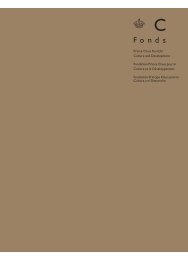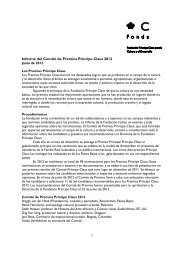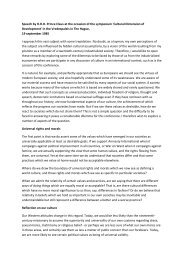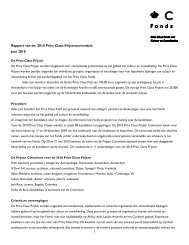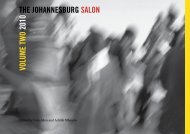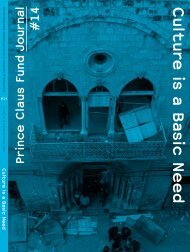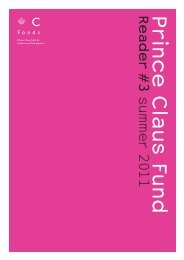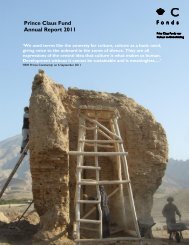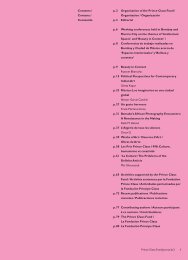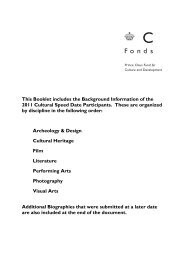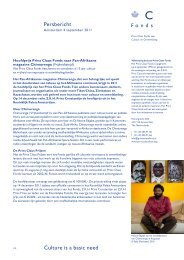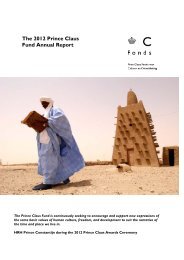Here - Prince Claus Fund
Here - Prince Claus Fund
Here - Prince Claus Fund
Create successful ePaper yourself
Turn your PDF publications into a flip-book with our unique Google optimized e-Paper software.
cans. The incorporation of these objects reflects the efforts of the urban<br />
poor to survive a difficult economic situation through the use of their artistic<br />
sensibilities. To Dono, recycling junk is an innovative practice because it is a<br />
cultural matter. ‘The facts show the efforts of poor people using tradition to<br />
survive in a difficult modern situation. The creations show how tradition<br />
continuously makes breakthroughs, not only for the sake of artistic means but<br />
more for survival,’ he believes.<br />
Heri Dono has worked with mechanics to develop the machinery of his<br />
installation from bits of old transistor radios. He knows the people who help him<br />
well. ‘They work every day at their small radio shops repairing used transistor<br />
radios. There are thousands of them in Yogyakarta. After repairing them, they<br />
sell the radios cheaply to the grassroots.’<br />
It is a matter of fact that in traditional Javanese society every person is a<br />
craftsman because they make their own utensils. However they also make works<br />
of art. The term for doing this kind of work is penciptaan. The direct<br />
interpretation of the penciptaan is creating. The term also has a unique<br />
meaning. The word penciptaan, derived from the term cipta meaning imagination,<br />
hopes, fantasies, and dreams, also includes the notion of communal idealism,<br />
shared values in daily life.<br />
Correspondingly, penciptaan means making dreams, fantasy and idealism<br />
become tangible or visual, through the capacity of hands by enforcing rasa<br />
(a kind of intuition) and the feeling of beauty that goes beyond sensation.<br />
This artistic practice is far from expressing opinions or making statements.<br />
Related to this, art in Javanese is kagunan, an activity of emitting feelings that<br />
express the beauty of moral ethics. The term kagunan is derived from guna,<br />
which means the insightful idiosyncrasy of a person.<br />
Perceiving this artistic sensibility, Heri Dono asked people to collaborate<br />
with him in making works of art, and those who were craftsmen graciously<br />
accepted the invitation. During the process of collaboration, these people did<br />
not just help Dono; they also gave him advice and ideas. Together they created<br />
works that not only show Dono’s convictions. The art also reveals the surprising<br />
dreams, hopes, fantasies, and beliefs of the urban poor in facing today’s harsh<br />
realities. And these, in turn, have enriched Dono’s representation of the world.<br />
This text was first published in the exhibition catalogue of Upside-down Mind, CP Artspace,<br />
Washington, DC, 2003. For information p. 174<br />
Heri Dono, Political Clown (detail), 1999<br />
38 <strong>Prince</strong> <strong>Claus</strong> <strong>Fund</strong> Journal #10a Tradition and Innovation



